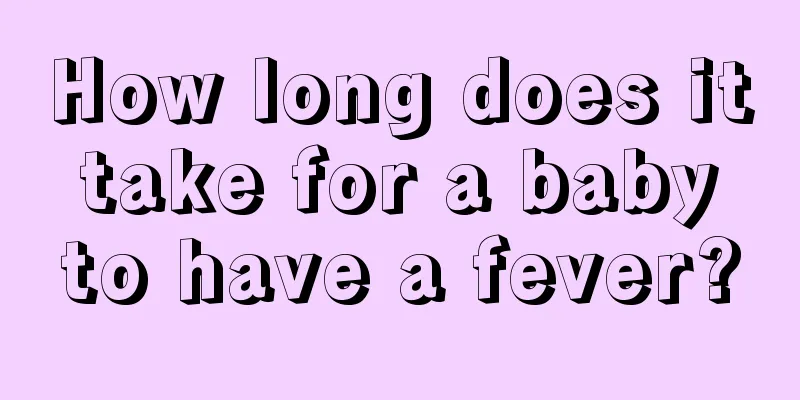How long does it take for a baby to have a fever?

|
Many parents are simply unable to deal with the problem of newborn fever. In fact, there are many factors that cause children to have a fever, including environmental changes, actual impacts in life, and temperature differences between indoors and outdoors. These are all reasons why children suddenly have a fever. Pay attention to adjusting the child and choose appropriate methods to control treatment. In this way, the baby can not only reduce the fever quickly, but also avoid some complications. Treatment Parents should conduct a preliminary assessment of their newborn's fever, that is, distinguish whether the fever is caused by environmental factors or disease factors. Secondly, choose a good and safe method to reduce fever. In real life, the most common reason for newborn babies to have fever due to environmental factors is excessive warming: such as too many clothes and too many blankets. Especially when the indoor temperature is close to 30℃, if the mother's milk secretion is insufficient, the newborn's milk intake will be reduced, which can cause the newborn to become dehydrated and cause the baby to have a fever. The fever caused by this factor will cause the baby to show symptoms of irritability, crying, flushed skin all over the body, hot hands and feet, and less urine. Parents do not need to panic if their children suffer from fever caused by this situation. By appropriately lowering the ambient temperature (the ideal living room temperature for newborns should be 22-25°C), loosening the quilt or adding more water, the baby's body temperature can return to normal. If a newborn baby has a fever accompanied by worsening reflexes, pale complexion, loss of appetite, and cold hands and feet, this is a fever caused by disease factors. Parents should deal with it rationally and it is best to send the baby to the hospital for examination in time. During transfer, the baby should be wrapped loosely and a cold water bag can be placed on the head. When the body temperature exceeds 39℃, you can first give a warm water bath or warm water sponge bath at home. The water temperature should be 33℃-35℃, and the sponge bathing areas should be the forehead, limbs, groin and armpits. Avoid using alcohol for bathing to prevent the body temperature from dropping sharply, even below 35℃, which will cause adverse effects. Generally, physical cooling is recommended when the baby's fever is below 38 degrees: 1. Ventilate more and pay attention to heat dissipation. 1. Keep the indoor temperature at 21℃~23℃; 2. Let the child rest in bed and sleep more. Ensuring adequate sleep can be beneficial to the recovery of the disease. Open the blanket or take off too much clothes, wear loose clothes, and avoid wrapping with a quilt; 3. Feed the child frequently with warm water or vitamin C juice, 250 ml a night. 4. Apply an ice pack to your forehead. 5. For high fever, you can use alcohol to wipe the baby's joints, take a warm bath, place the child in warm water 4℃~6℃ lower than body temperature for 5~10 minutes, then wipe the whole body dry with a large towel and gently massage the skin until it turns red; you can also use 32℃~34℃ warm water, which is not hot enough for the skin on the inside of an adult's wrist, to bathe the child, focusing on scrubbing the forehead, neck, armpits, groin and limbs. The whole bathing time is 10~15 minutes, until the child's temperature drops to 38℃, etc.). This physical cooling method is very effective. Precautions Generally, antipyretic drugs, such as Anesthesia drops and Tylenol, should be used only after the body temperature reaches 39 degrees. When infants and young children under 3 years old have a high fever, physical cooling methods should be used first. Generally, antipyretic injections and antipyretic drugs are not required to avoid collapse and drug toxicity reactions. Various antipyretics such as aspirin and phenacetin can easily produce toxic effects in the neonatal period or cause collapse at slightly larger doses, so antipyretics should be used with caution when the newborn has a fever. When the room temperature is too high, try to lower it and slightly loosen the newborn's blanket to facilitate heat dissipation. If the baby is wrapped too tightly, the heat will not be able to dissipate and the body temperature will rise further. If the newborn's body temperature exceeds 39 degrees, you can use a warm towel to wipe the forehead, neck, armpits, limbs and thighs to promote heat dissipation from the skin. At this time, you should also feed your baby more boiled water to help excrete toxins. |
<<: How many days will it take for baby's allergy to heal?
>>: How long does it take for baby eczema to heal?
Recommend
What to do if your baby has wax in his ears
The buttery earwax in the baby's ears is also...
Symptoms of developmental dysplasia of the hip
When many parents take their babies to the hospit...
Why does my child keep spitting?
It is a bad phenomenon for children to spit all t...
Can children drink carbonated drinks?
Many children like to drink carbonated drinks, es...
Is medication effective for children’s pharyngitis? What is the best way to deal with it?
Children's respiratory diseases have a partic...
What are the reasons why babies sweat easily?
We all know that sweating can eliminate toxins ac...
Heat rash on newborn baby
Many people know that newborns are a relatively v...
Best treatment and care for newborn baby eczema
After birth, newborns are not yet well adapted to...
Why does the baby cry for no reason?
In the process of taking care of the baby, the mo...
How to remove birthmarks
Many newborn babies may be found to have birthmar...
How to reduce the harm of smog to children, do you know the three measures?
The harm of haze to children is immeasurable. We ...
What should I do if my child has a fever after vaccination?
Because there are so many uncertain diseases that...
2 month old baby has not had a bowel movement for 15 days
We all know that when the baby is two months old,...
Can bronchial asthma in children be cured?
Bronchial asthma is very common among children in...
What causes indigestion in children?
In life, our mothers may not give their children ...









